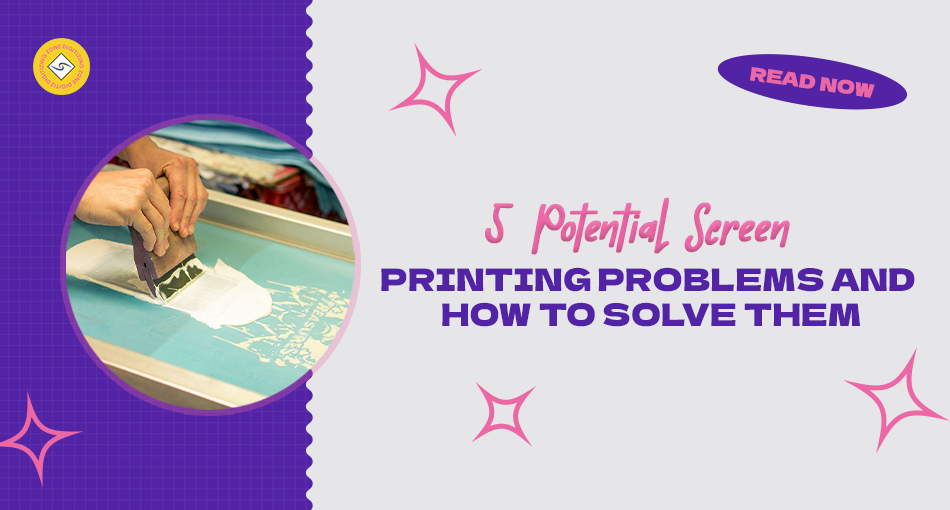Troubleshooting Common Screen Printing Problems
Screen printing can be a challenging process, often presenting issues with ink, registration, and other factors. In this article, we’ll discuss five potential screen printing problems and how to solve them. Understanding these issues and their solutions will help you achieve high-quality screen prints with fewer challenges, whether you’re a beginner or a seasoned printer.
What is Screen Printing?
Screen printing on fabric is a popular technique that uses a stencil and ink to print designs onto various surfaces, including fabric, paper, and wood. While it can be a rewarding process, beginners might find it challenging. Let’s explore five common screen printing problems and their solutions.

Five Potential Screen Printing Problems
1. Ink Bleeding
Ink bleeding occurs when the ink seeps outside the intended area, resulting in a blurry or smeared print. This can be caused by using too much ink, insufficient pressure on the screen, or a low mesh count screen. Additionally, bleeding can occur if the ink is not properly cured or if the fabric is not prepped correctly.
Solution:
- Use the right amount of ink for your design.
- Ensure your screen is properly prepared, using a high-quality mesh screen stretched correctly and coated with a high-quality emulsion.
- Properly cure the ink by following the recommended curing time.
- Pre-treat the fabric correctly before printing.
2. Poor Registration
Poor registration happens when the printed design is misaligned. This can result from an improperly aligned screen, incorrect pressure during printing, or not adjusting the off-contact distance correctly.
Solution:
- Align your screen properly before printing.
- Use a registration system to ensure correct alignment.
- Adjust the off-contact distance to avoid the screen being too close or too far from the substrate.
3. Pinholes
Pinholes are small holes that appear in the printed design, often due to an improperly prepared screen, insufficient emulsion, or using a high mesh count screen.
Solution:
- Prepare your screen properly, using a high-quality mesh screen stretched and coated with high-quality emulsion.
- Clean the screen with a degreaser before use and ensure it is completely dry before coating it with emulsion.
- Use the correct squeegee pressure and angle during printing.
Ink Color Fading
Ink color fading can occur over time, particularly on fabric. This can be due to low-quality ink, improper curing, or inadequate fabric preparation.
Solution:
- Use high-quality ink suitable for the fabric type.
- Properly cure the ink by following the recommended curing time.
- Wash and dry the fabric before printing to remove any residues or chemicals.
5. Ghosting
Ghosting occurs when a design from a previous print run appears on a subsequent print run, causing a blurry or distorted design. This can be due to not cleaning the screen properly between runs, excessive pressure during printing, or improper ink curing.
Solution:
- Thoroughly clean your screen between print runs with a cleaning solution or high-pressure washer.
- Use a fresh squeegee for each print run.
- Ensure the ink is properly cured before handling or stacking the printed items.
Conclusion
Screen printing is a versatile and popular method for producing high-quality and durable prints. However, it comes with its challenges. By understanding and addressing common problems like ink bleeding, poor registration, pinholes, ink color fading, and ghosting, you can enhance your screen printing process.
Preparation, attention to detail, and regular maintenance are crucial. Properly prepare your screens and items, use the right ink and emulsion, and carefully time your exposure. Clean and maintain your screens regularly to prevent clogs and ghosting, and ensure that your ink is properly cured before handling or stacking.
With practice and experience, you can refine your technique and produce consistent, high-quality prints. Don’t be discouraged by challenges; use them as opportunities to learn and improve. By implementing these best practices, you can create prints that are both beautiful and long-lasting.
If you’re looking to digitize your embroidery designs or convert them into vector art, consider professionals like Digitizing Zone. With over 20 years of experience, Digitizing Zone offers comprehensive embroidery digitizing services and vector art services worldwide, known for high-quality, durable results at reasonable prices. Enjoy a 20% discount on all services as a potential customer.
We hope this guide helps you with your screen printing projects. If you have any questions, feel free to ask in the comment section, and don’t forget to share this with anyone who might find it helpful. Thank you for reading!



